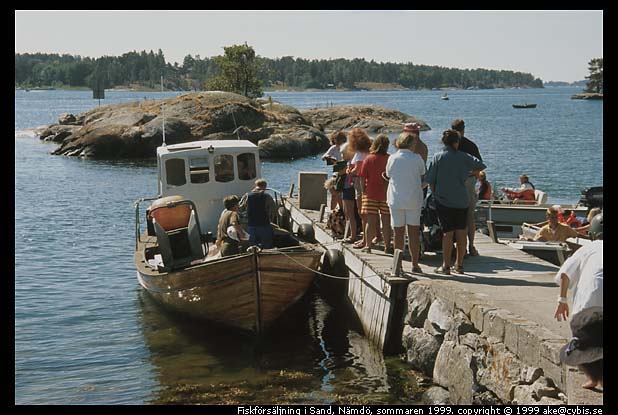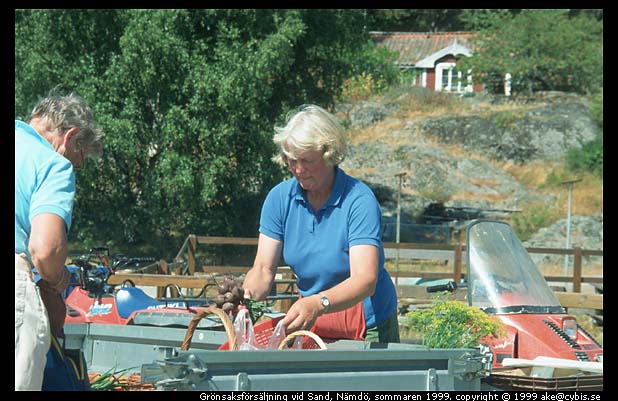 |
|
The island of Nämdö is situated about 25 miles east of central Stockholm, Sweden.
|
 |
|
Nämdö is one of the smaller of the large islands in the Stockholm archipelago.
It is about 4 miles long and a little less than 2 miles wide.
Though the bedrock is seen everywhere there is also some farmland.
Those areas marked with yellow color on the map were used as farmland in the 1930's.
Until the 1950's there were four farms and a small market garden on Nämdö.
On all these places they had milch cows. Most of the farmland is still open without any trees and bushes.
Parts of northern Nämdö is owned today by
Skärgårdsstiftelsen, a public service organization.
On that area is a farm "Östanvik" with cows, sheep and chickens. During the summer the sheep
and cows graze both on Nämdö and on the small islands outside Nämdö.
|
 |
You can go for a trip to Nämdö by "Waxholmsbåt" (small ferry) either from Saltsjöbaden or
from Stavsnäs. (There is a train from Slussen to Saltsjöbaden and there are busses from Slussen to
Stavsnäs.) During the season without ice, you also have some more or less scheduled taxi boats
going from Stavsnäs to Nämdö.
There are no automobiles on the island, though there are some "four wheeled motor cycles".
|
 |
During the winter season from Christmas to Easter (sometimes longer than that) the ferries solely
depart from Stavsnäs.
About 50 people are living all the year round on Nämdö and another 50 on the surrounding
islands. There is a school in Sand at Nämdö but not for children in senior high school. They
have to visit the main land and live there during the work week.
Now, in 2008, the school is closed as there are currently not enough children on these isles.
|
 |
|
A local shipping company "Strömma Kanalbolaget" runs a tour around the skerries each day from Midsummer
until the middle of August. This tour named "1000 öars kryssning" (The tour of the 1000 islands) is run
with a renovated old steamship, Waxholm III, though it has a modern engine today. This ship departs from
Stockholm in the morning, passes through "Stäket" at Saltsjöbaden and then visits Kymmendö,
Bullerö, Sandhamn and Vaxholm. It is back in Stockholm in the evening.
When it is too windy, then Nämdö is visited instead of Bullerö.
|
 |
 |
|
The Waxholm III visit at Nämdö lasts for about 40 minutes. You may decide to visit the church or ...
|
 |
|
... to visit a branch of "Skärgårdsmuseet" at the old
school building at Nämdö. Here you will find a small exhibition. There are also handicraft products for
sale. They are made at Nämdö and on the surrounding islands.
You can also have a cup of coffee or an ice-cream.
|
 |
|
Some years ago, on Wednesdays and Saturdays in the height of the summer, there were market days at Sand.
There you could buy new potatoes, vegetables, berries and flowers.
|
 |
 |
|
There was also fish at the Sand market. Best was to order in advance - just to make sure...
|
 |
|
Here, Olle Fernlöf is busy selling fish which he has caught himself.
Olle lives on the island of Gillinge outside Nämdö.
|
 |
|
Vegetables are grown not only at Östanvik but also at Västerängen. Here Wilma Latos from
Västerängen is busy selling red beets. She also had a wonderful rye bread and other loaf of bread.
One more thing: You can get
Bed and Breakfast at Västerängen!
|
 |
At Solvik, a little bit north of Sand, there is a general store where you can buy food. There are
also lots of other things found at a general store like common nails but also big nails to be seated into
the rock (used when building jetties). Moreover, you can find some medical supplies and
also order liquor, wine and beer and then usually collect it two days later. (In Sweden we are supposed to
plan our liquor, wine and beer drinking, preferably several days in advance.) Opening hours and days
varies depending on the season.
During the summer you can visit a restaurang, "Hamnkrogen", next door to the general store.
For more information about the general store
and their services, click
here or
|
 |
As already told, Nämdö is a farming island. Though, the patches of arable land are scattered around.
You may find them small, but they have fed their farmers for long past times.
On the map is a small area which is painted with red. If you are standing at the southern border
of that area and if your are looking in the northeast direction ...
|
 |
|
... you will see this. This area has been used as a farming land at least since 1638. We have a map from
that time...
|
 |
On the Östanvik
farm, Albert Matsson and Camilla Strandman are running the farming.
There are more stories about them in some of the other photo galleries.
See also www.namdo.nu
|
















